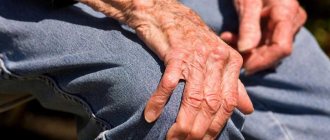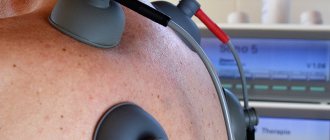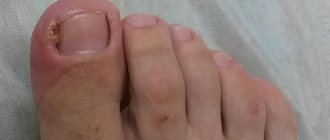What provokes / Causes of Trichinosis:
Trichinella are small, almost thread-like helminths (thrix - hair), covered with a transversely striated cuticle. The body of T. spiralis is rounded, somewhat narrowed towards the anterior end. The length of a sexually mature male is 1.2-2 mm with a width of 0.04-0.05 mm. The length of a sexually mature female before fertilization is 1.5-1.8 mm; after fertilization, its length increases to 4.4 mm.
The existence of two types of foci of trichinosis has been established: natural and synanthropic. Natural foci are primary in origin. Trichinella can parasitize the body of 57 species of wild and domestic animals; the circulation of the pathogen is based on nutritional connections. In these foci, parasites circulate among wild animals (wild boars, badgers, raccoon dogs, brown and polar bears, foxes, martens, minks, ferrets, etc.), marine mammals (whales, harbor seals) due to predation or eating carrion. In synanthropic foci, Trichinella circulates among domestic animals (pigs, cats, dogs), rodents (mice, rats), also by eating each other or carrion. In addition, synanthropic foci are replenished by hunting trophies - trichinosis wild animals.
There is a direct and inverse relationship between natural and synanthropic foci. Invasion from natural foci is introduced into synanthropes in two ways: by humans, who hunt infected wild animals and feed their remains to domestic animals, and by wild synanthropes (rats, mice), which migrate to natural foci in the spring and return back in the fall. As a result, mixed natural-synanthropic foci are created.
In the muscles of animals, the larvae remain infective for years, and in cadaveric material they die under the influence of very high or low temperatures (-40, -50°C) and can tolerate conditions in the Arctic zone.
The source of infection for humans is domestic and wild animals affected by trichinosis. Most often these are pigs, wild boar, brown and polar bears, nutria, badgers, foxes, and for some nationalities - dogs.
The mechanism of infection is oral. People's susceptibility to trichinosis is very high. In order to get a serious illness, it is enough to eat 10-15 g of trichinosis meat. Infection usually occurs when eating raw or undercooked meat from animals affected by trichinosis, most often meat, lard, ham, bacon, brisket, brisket, sausage made from infested pork, as well as meat from wild animals affected by trichinosis (bear, wild boar, badger ).
The incidence of trichinosis is usually group in nature. Members of the same family, persons participating in the same festive feast, hunting meal, and those who used the meat of the same trichinosis animal that did not undergo preliminary sanitary and veterinary control become ill.
Trichinella larvae die when the temperature inside a piece of meat reaches at least 80°C. Salting and smoking meat does not affect encapsulated larvae.
The seasonal nature of group outbreaks has been established. In synanthropic foci, they are in most cases associated with the autumn period - the period of slaughtering pigs and procuring meat products.
Outbreaks of trichinosis in natural foci are associated with the hunting season - the autumn-winter period. Due to existing poaching, they can occur at any time of the year.
The formation of foci of trichinosis is facilitated by improper management of pig farming: free keeping of pigs, their wandering, access to pigsties for rodents, cats, and dogs.
Life cycle of Trichinella
Trichinella are viviparous helminths. An important biological feature is also that the same organism becomes first the definitive and then an intermediate host. Trichinella has a variety of hosts other than humans. They parasitize many mammals - pigs, wild boars, bears, wolves, foxes, badgers, dogs, cats, as well as rodents, insectivores and marine mammals.
In the sexually mature stage, helminths parasitize in the wall of the small intestine, and in the larval stage - in the striated muscles, except for the heart muscle.
A person becomes ill with trichinosis by eating pork or wild animal meat contaminated with encapsulated larvae. During the digestion process, the larvae are released from the capsules and within an hour they penetrate the mucous membrane, reaching the submucosal layer of the small intestine.
After a day they turn into males and females. Sexually mature individuals, using the head stylet, are attached to the intestinal mucosa, where they then copulate.
In the body of various animals, the female Trichinella parasitizes from 10 to 56 days, giving birth to from 200 to 2000 live larvae. During the entire period of parasitism in the human intestine (no more than 42-56 days), one female gives birth to an average of 1,500 larvae.
The larvae penetrate through the intestinal mucosa into the lymphatics, then into the blood vessels and are carried throughout the host’s body by the blood stream. On the 5-8th day, the larvae enter the skeletal striated muscles. With the help of the hyaluronidase they secrete, they penetrate into the sarcolemma of the muscle fiber, where their further development occurs, already in the body, which has become an intermediate host for the pathogen. 18-20 days after infection, the larva in the muscles lengthens to 0.8 mm, reaches the invasive stage and begins to curl up.
Mechanism of infection
In all cases, infection occurs due to eating the meat of sick animals, i.e. the mechanism of infection is nutritional. It is especially dangerous to eat cured meats and undercooked meats. When salted, the larvae in the depths of the piece can survive for up to a year.
The larvae tolerate low and high temperatures quite well. At temperatures below -20 C they survive for up to three days, but the higher the temperature, the longer the larva survives. In the freezer (temperature about -10 C) the larva does not die for up to a year. When frying, if the temperature of the meat reaches +50 C, the larvae die within a few minutes. But if the animal has been sick for a long time, a calcified capsule could have formed around the larva, in which case the temperature is not capable of killing the larva.
Pathogenesis (what happens?) During Trichinosis:
The pathogenesis of trichinosis is complex, representing a complex of pathological reactions, the trigger of which is the pathogen.
As is known, the entire biological cycle of Trichinella takes place in the body of one host, in this case, a person, in which successive stages of helminth growth have different localizations: the infective larva in the lumen, and then in the mucous membrane of the small intestine; a growing and then adult individual in the tissue of the small intestine; migratory larva - in the bloodstream and lymph; muscle larva - in striated muscles. As a result, the products of metabolism and partial decay, especially of larval and growing individuals, enter directly into the tissues. They are parasitic antigens with high sensitizing activity.
The allergic nature of trichinosis underlies its pathogenesis. N. N. Ozeretskovskaya distinguishes three phases of development of the pathological process: enzymatic-toxic (1-2 weeks after infection), allergic (from the end of the 2nd -3-4 weeks after infection) and immunopathological.
The enzymatic-toxic phase is associated with the penetration of invasive Trichinella larvae into the intestinal mucosa and the formation of adult helminths, under the influence of enzymes and metabolites of which an inflammatory reaction develops in the intestine.
The second, the allergic phase of trichinosis, is characterized by the occurrence of general allergic manifestations in the form of fever, myalgia, edema, skin rashes, conjunctivitis, catarrhal pulmonary syndrome, etc. By the end of the first week, mature adult Trichinella begin to hatch young larvae, which migrate through the lymph and blood to striated muscles. The suppressed protective reaction of the host due to the immunosuppressive effect of adult parasites does not prevent the active circulation of larvae.
However, by the end of the second - third week of the disease, the level of specific antibodies in the serum of the infected person increases and a violent allergic reaction develops.
Violent allergic inflammation in the small intestine contributes to the death of adult Trichinella, the formation of granulomas around Trichinella larvae in the muscles, from which fibrous capsules are subsequently formed that prevent the entry of parasite antigens into the host body.
The severity of immunological reactions depends on the dose of the antigen and the immunoreactivity of the host organism, on the degree of adaptation of the parasite to the host. An increase in the dose of infection causes an increase in the intensity of intestinal and muscle invasion, which in turn leads to an increase in the severity of the disease and inhibition of immunological processes. This is accompanied by systemic damage to organs and tissues as a result of sensitization of the body not only by the metabolic products of helminths, but also by the decay products of damaged or destroyed host tissues. This phase is manifested by fever, muscle pain, swelling, conjunctivitis, and respiratory problems.
The immunopathological phase of trichinosis, usually associated with intense infection, is characterized by the appearance of allergic systemic vasculitis and severe organ damage.
Nodular infiltrates occur in the myocardium, brain, lungs, liver and other organs. Trichinosis is complicated by severe allergic diffuse focal myocarditis, meningoencephalitis, focal pneumonia and other equally severe organ lesions, which can be combined with each other, accompanied by high fever, severe muscle pain, skin rashes, and the spread of edema.
By 5-6 weeks after infection, the inflammatory process in parenchymal organs is replaced by dystrophic disorders, which recover slowly over 6-12 months.
Treatment
Treatment is carried out only in a hospital setting, because high risks of serious complications. Treatment includes controlling adult worms and relieving symptoms. Antihelminthic drugs are used against nematodes. The drug and dosage are prescribed by the attending physician. Antipyretic, anti-inflammatory and hormonal drugs are used to relieve symptoms. In addition, due to muscle damage, physiotherapeutic procedures and massage are necessary. Stabilize blood flow and administer vitamin therapy.
Diagnostics
The diagnosis of trichinosis is established on the basis of the clinical picture of the disease (fever, myalgia, facial swelling, blood eosinophilia), a corresponding epidemiological history, as well as the detection of Trichinella larvae in meat, suspected as a factor in the transmission of the infection. Epidemiological history is very important for recognizing trichinosis, especially in group diseases, when consumers of the same meat, lard, sausages, etc. are sick. The group nature of the disease, the commonality of the infection transmission factor, blood eosinophilia and the listed main clinical signs usually indicate trichinosis.
If it is impossible to study the meat that served as a factor in infecting people, in diagnostically difficult cases they do a biopsy of the sick person and look for Trichinella under a microscope in sections of muscle tissue. In order to minimize trauma, the calf muscles are usually used as an object. There are also serological tests for trichinosis - ring precipitation test, complement fixation test, enzyme immunoassay and others. However, in the first 2–3 weeks after infection, and in severe cases even later, these reactions may be negative.
Differential diagnosis
For single diseases of trichinosis, the differential diagnosis is made with drug allergic reactions, Quincke's edema, and dermatomyositis. Anamnestic data are very important in distinguishing between trichinosis and these diseases.
With Quincke's edema there is no fever and organ damage characteristic of trichinosis.
With dermatomyositis, unlike trichinosis, the disease develops more slowly. There is a peculiar hyperemia of the face, not typical for trichinosis, and dystrophic changes in the skin. There are no Trichinella larvae in muscle biopsies.
In addition, during outbreaks it is necessary to carry out a differential diagnosis of trichinosis with trematodes - opisthorchiasis, clonorchiasis, paragonimiasis, with the larval stages of ascariasis and toxocariasis, with typhoid and typhus.
Trematodes of the liver and lungs can also acquire the size of group diseases and outbreaks. However, the epidemiological history of trematodes differs from that of trichinosis. In the case of opisthorchiasis and clonorchiasis, this means eating raw or insufficiently heat-treated river fish, and in case of paragonimiasis, this means eating freshwater crayfish or crabs.
With liver trematodes, abdominal syndrome and signs of diffuse liver damage (jaundice, hepatosplenomegaly, changes in liver function tests) are more pronounced. At the same time, with trematodes, myalgia and edema syndrome are less pronounced.
However, in some cases with trichinosis, toxic-allergic hepatitis develops very early, which greatly complicates the differential diagnosis with liver trematodes.
With paragonimiasis, changes in the lungs with the presence of persistent clinical and radiological signs of damage to this organ come to the fore in the picture of the disease. With paragonimiasis, the pleura is often involved in the pathological process, often with effusion into its cavity, and there is often “rusty sputum.”
Serological tests for trichinosis come to the rescue. However, one should take into account the possibility of false-positive reactions to trichinosis in patients with opisthorchiasis and paragonimiasis. Particular difficulty in differential diagnosis is presented by atypical severe forms of trichinosis, which are often the earliest in group diseases. In the clinical picture of these forms of trichinosis, severe dyspeptic disorders - vomiting, diarrhea, sometimes with dysentery-like stools - may come to the fore, but high fever, myalgia, hypereosinophilia of the blood - the most important diagnostic signs of trichinosis - are not yet present. This greatly complicates the recognition of trichinosis and leads to erroneous diagnoses of food poisoning, salmonellosis, shigellosis, and typhoid fever. Often, the correct diagnosis of trichinosis during outbreaks of this disease is made late, 1.5–2 weeks after the onset of the first diseases, when less severe, but typical forms of trichinosis appear. A delayed diagnosis of trichinosis can have fatal consequences for the people who first become ill in such outbreaks.
Clinical examples
In one of the settlements, an outbreak of trichinosis occurred, affecting 25 people, mostly adults. When analyzing the epidemiological history, it was found that all patients consumed bear meat in one form or another some time before the onset of the disease. All the sick people turned out to be either relatives or close acquaintances of the hunter who killed this bear. The hunter himself fell ill. Fortunately, none of this group of patients died.
An outbreak of trichinosis among geologists ended more sadly. They also became infected through bear meat. When examining the remains of this meat, Trichinella larvae were found in every field of view. Of the 8 people treated in our clinic, one patient died. He was a big fan of planed bear meat.
One day a patient with a severe form of trichinosis was brought to our clinic. Shortly before her illness, the patient slaughtered two pigs, which she raised in an apiary, and made sausages. Testing pig meat for trichinosis gave a negative result. Only after some time, when the attending physician gained special confidence in the patient, we were able to find out the circumstances of her infection. It turned out that when preparing sausages, this beekeeper added to the meat of domestic pigs the meat of a wild boar that her husband had killed.
Consequences and complications
Trichinosis is a deadly disease that leads to various organ damage, including the liver, kidneys, and severe complications usually occur in the 3-5th week of the disease. These include:
- trichinosis myocarditis , which can provoke the development of acute cardiovascular failure ;
- pneumonia - usually characterized by a diffuse increase in the vascular pattern and the presence of pleural lesions;
- meningoencephalitis;
- infectious-toxic shock;
- abdominal syndrome;
- paralysis and paresis are the result of nonspecific vasculitis and diffuse focal granulomatosis in the brain and/or spinal cord;
- thrombosis of large vessels.
Prevention
Prevention measures include:
- Proper cooking of animal meat. Since high temperatures are not always effective, freezing meat at -20 for 3 or more days is recommended.
- If you suspect that an animal is sick, examine the meat or do not use it for food.
- When grazing domestic animals, prevent them from eating dead animals.
Rospotrebnadzor inspects animals raised for meat; therefore, sales are not carried out without inspection. But buying meat from private individuals without checking for helminths can pose a health risk. You can check meat for helminths at sanitary and epidemiological stations and veterinary laboratories.
Get a consultation with a gastroenterologist











